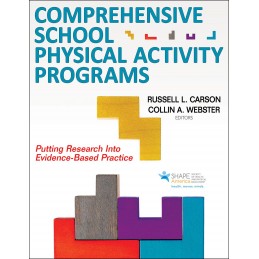Schools are the ideal place to promote and apply the recommended accumulation of 60 minutes of daily physical activity. But until now, it has been difficult to bridge the gap between research in this area and day-to-day practice in order to establish solid programs.
That’s where
Comprehensive School Physical Activity Programs:: Putting Research Into Evidence-Based Practice comes in.
CSPAP Model Brought to Life The comprehensive school physical activity program (CSPAP) model, originally outlined as a 2008 position statement by the National Association for Sport and Physical Education to promote physical activity throughout K-12, is brought to life through this comprehensive, all-in-one resource. In the decade since that position statement, CSPAP has been spreading through numerous initiatives, which have mobilized a CSPAP field of study and a national framework for physical activity and physical education. CSPAP acts as a hub, supporting physical activity through multiple components that can include physical education; physical activity before, during, and after school; staff involvement; and family and community engagement. Moreover, each CSPAP component can serve to strengthen and reinforce the academic goals of physical education.
Accommodates Needs of Diverse AudiencesComprehensive School Physical Activity Programs, published in association with SHAPE America, accommodates the growing needs of academic researchers, school practitioners, district coordinators, educators, advocates, organizations, university faculty, and students who want to learn more about CSPAP or undertake ways to increase daily physical activity opportunities in and around schools.
The Text’s Strengths This text does all of the following and more:: Synthesizes all the foundational and emerging research, theory, and practice on CSPAP
- Synthesizes all the foundational and emerging research, theory, and practice on CSPAP
- Provides a higher- and deeper-level look at the CSPAP model, as opposed to short reports and position papers, which contain limited strategies for schools
- Offers much more in-depth coverage of the CSPAP model by delving into assessment, evaluation, advocacy, policy, partnerships, international perspectives, technology, and more
Diverse and Renowned Team of ContributorsComprehensive School Physical Activity Programs was written by a diverse team of pioneers and leaders in the CSPAP field. This team brings national and international perspectives on all aspects related to implementing and maintaining CSPAP in K-12 schools. These recognized experts provide incisive guidance in, and understanding of, the most prominent concepts, issues, and developments in the field.
Book Organization The text is organized into six sections::
- Part I provides the historical and foundational perspectives and policy landscapes of the CSPAP approach.
- Part II outlines internal, external, and psychological factors to consider in program design, implementation, and sustainability.
- In part III, the contributors examine and interpret the research on the effectiveness of established programs and previous interventions.
- Part IV highlights special considerations for effective programming within urban and rural settings, reviews current and ongoing international CSPAP initiatives, and addresses the application of the model to alternative contexts beyond the K-12 school setting.
- In part V, the contributors focus on using assessments to determine the physical activity promotion needs of a school community, on the instruments and procedures for measuring school-wide programming, and on the processes for evaluating and advocating for CSPAPs.
- Part VI examines current reform efforts within preprofessional programs in teacher education, reviews the tools and future potential for using technology to deliver and assess CSPAP efforts, and looks at future directions for the disciplines of study that inform the CSPAP knowledge base.
Each chapter uses a format that opens with a review of
current research, offers
knowledge claims based on the research, notes
knowledge gaps and directions for future research, offers evidence-based
recommendations and applications, and concludes with
questions to consider for discussion and
case examples to demonstrate the practical recommendations.
An Invaluable Resource The rapid growth of the field and the increasing number of diverse and exceptional scholars (many of whom are contributors to this book) are indications of the need for this resource.
Comprehensive School Physical Activity Programs offers unique perspectives about how to generate and sustain successful initiatives to increase youth physical activity and promote long-term engagement in active behavior. It provides access to leading thought, invaluable tools, and challenging questions that will propel the CSPAP field to its next level of depth and clarity.


 Dostawa
Dostawa
 Płatność
Płatność
 Zwroty
Zwroty
